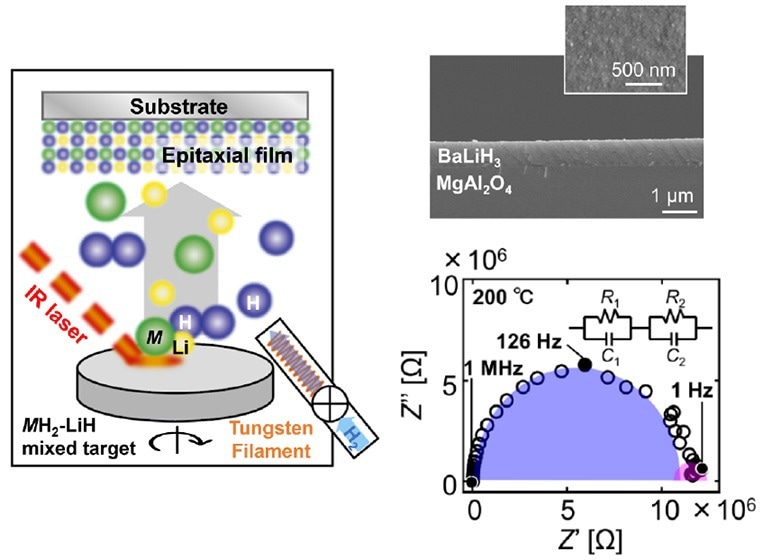In a new study published in ACS Applied Energy Materials, researchers from Shibaura Institute of Technology tackle the challenge of measuring perovskite hydrides' intrinsic hydride-ion conductivity using a unique laser deposition process in an H-radical atmosphere.
 Epitaxial thin film growth through an innovative deposition technique. The novel setup developed for this study enables the growth of single crystals of ternary perovskite hydrides, which is notoriously challenging. In turn, these high-quality crystals in thin films can be used to measure the intrinsic hydride-ion conductivity of these perovskites, as shown in the bottom-right figure. Image Credit: Erika Fukushi from Shibaura Institute of Technology
Epitaxial thin film growth through an innovative deposition technique. The novel setup developed for this study enables the growth of single crystals of ternary perovskite hydrides, which is notoriously challenging. In turn, these high-quality crystals in thin films can be used to measure the intrinsic hydride-ion conductivity of these perovskites, as shown in the bottom-right figure. Image Credit: Erika Fukushi from Shibaura Institute of Technology
Perovskite hydrides are intriguing materials for various new energy systems, but determining their intrinsic hydride-ion conductivity is challenging. Using this method, they created thin-film single crystals of two distinct perovskite hydrides and characterized their hydride-ion conductivity. These initiatives will help advance research into hydrogen-related materials.
Perovskites are now a popular issue in material science due to their exceptional features and possible applications, which include sustainable energy technologies, catalysis, and optoelectronics, to mention a few.
Perovskite hydrides, which contain hydrogen anions (H−), are known for their hydrogen-derived characteristics. Many experts think these compounds will be important in researching and developing hydrogen storage technologies such as fuel cells, next-generation batteries, and energy-saving superconducting cables.
Despite being a novel platform for applied materials research, defining perovskite hydrides' physical characteristics has proven difficult. Specifically, measuring these crystalline materials’ H− conductivity is difficult.
Since most studies employ powdered materials for their characterization analyses, the crystals' imperfections (also known as “grain boundaries”) impact H− conduction.
A uniform, continuous single crystal with the fewest feasible imperfections must be created to get accurate measurements for the intrinsic H−conductivity of a particular perovskite. This is challenging, and only a few research organizations have tried to find complicated ternary perovskite hydrides.
A group of researchers, comprising Doctoral course student Erika Fukushi from the Department of Regional Environment Systems of the Graduate School of Engineering and Science at Shibaura Institute of Technology (SIT), Japan, decided to take up the task.
The researchers used an innovative technique to generate high-quality single crystals and conducted some of the first intrinsic conduction measurements on ternary perovskite hydrides. Fumiya Mori, Kota Munefusa, and Hiroyuki Oguchi from SIT and Takayuki Harada from the National Institute for Materials Science co-authored the study.
To create the perovskite single crystals, the researchers pioneered a powerful method known as “H-radical reactive infrared laser deposition.” This method includes shining an infrared laser over a revolving disk-shaped pellet holding the metal atoms of the desired perovskite.
The researchers aimed to make MLiH3 (where M is either Sr or Ba); therefore, the pellet was formed from a crudely compacted mixture of MH2 and LiH powders. As the laser heated the pellet, the metals were released into the surrounding H-radical-rich atmosphere, created by pumping hydrogen into the reaction chamber via a heated tungsten filament.
Nearby, the pellet was a carefully chosen substrate on which the hydrogen and metals spontaneously interacted to produce the correct perovskite. As atoms began to build up on the substrate, they spontaneously organized and oriented themselves in accordance with the crystal layers underneath them. This resulted in the epitaxial development of a nanofilm on the substrate.
Our approach is unique in its ability to perform deposition in a radical hydrogen atmosphere, significantly promoting the reaction between the metal and hydrogen. This results in the synthesis of single-phase hydride thin films by fully hydrogenating the metal atoms that naturally tend to persist in the film.
Erika Fukushi, Doctoral Student, Department of Regional Environment Systems, Graduate School of Engineering and Science, Shibaura Institute of Technology
The researchers conducted numerous laser depositions under various circumstances and carefully analyzed the resultant thin films. They used various sophisticated methods, including X-Ray diffraction, atomic force microscopy, and scanning electron microscopy, to determine each film's elemental distribution and crystallinity. In this method, they found the best conditions in their experimental setup for producing well-ordered, single-crystal MLiH3.
It was not until the scientists confirmed that there were no grain boundaries in the films that they could finally detect H−conductivity. Notably, these were the first measurements of these crystals' intrinsic H−conductivity, important information for selecting materials in various applications connected to hydrogen.
Fukushi added, “Novel secondary batteries and fuel cells may be developed using hydride-ion conduction. Such technologies could encourage the spread of electric vehicles and renewable energy, ultimately contributing to the construction of an energy-saving sustainable society.”
Hopefully, this novel approach to growing superior perovskite hydride crystals will lead to discoveries in hydrogen materials research and pave the path toward sustainability.
Funding Information
The study was supported by a Grant-in-Aid for Challenging Exploratory Research (7K19 K22225) from the Japan Society for the Promotion of Science, the 56th Kowa Lithium Award from L-GRANT Research, the S-SPIRE project at Shibaura Institute of Technology (23017), the NIMS Collaboration Center Promotion Program (2022-87) (2023-024), and JST PRESTO (JPMJPR20AD) from the Japan Science and Technology Agency.
Journal Reference:
Fukushi, E. et al. (2024) Epitaxial Thin Film Growth of Perovskite Hydrides MLiH3 (M : Sr, Ba) for the Study of Intrinsic Hydride-Ion Conduction. ACS Applied Energy Materials. doi:10.1021/acsaem.3c03188.